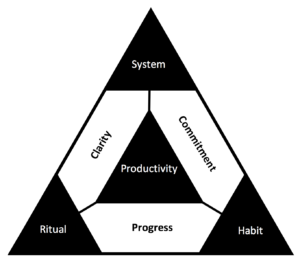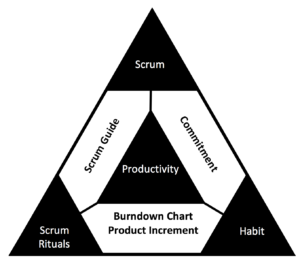Productivity Patterns
My Past Experience
Be it get-rich-quick schemes or rapid-weight-loss solutions, the Internet is littered with a million improvement schemes. In my many years of attempting to improve productivity for my clients and myself, I’ve tried just about everything. Regardless if the post, podcast, or book is promising to do twice the work in half the time or that you can cram an entire work week into 4 hours, there is something out there for everyone. My first venture into this productivity-focused world was way back in the early 90s, when I watched this horrible movie titled Taking Care of Business, starring Jim Belushi and Charles Grodin. In the movie, an uptight advertising exec has his entire life in a filofax organizer which mistakenly ends up in the hands of a friendly convict who poses as him. The movie is still horrible but the organizer idea seemed to work for me.
Franklin Covey Planner
From this movie, I discovered the Franklin Covey Planner. Yep, my world was filled with A1, B1, C1’s. Alas, I couldn’t make it work. Much like the guy in the movie, everything was in a little leather book with special pages (that were not cheap). Unfortunately, if I didn’t have the book in my field of view to constantly remind myself, things didn’t get done. I think I lasted a year, until I discovered the cost of refilling the book with new pages.
GTD
I then discovered GTD (Getting Things Done) by David Allen. This was 15-20 years ago. Again, it worked for a little while but I then found myself doing too much organizing and too little doing. Things were going away from paper filing and everything in that system was all about paper filing. Maybe I was doing it wrong. It just wasn’t clear to me. I didn’t see any real progress or productivity improvement so I just stopped doing it.
Personal Kanban
In mid 2009, in a moment of Internet serendipity, I ventured into the world of Personal Kanban. I think I searched “Zen” and up popped a website for a Kanban tool. I started using it and loved it. Alas, that company got purchased by Rally and they are no longer taking registrations. But, this has become the first system I have been able to stick with. Just to try other tools, I soon switched over to LeanKit Kanban. I’ve been using it ever since. I like that it doesn’t make any promises it can’t keep. “Visualize your work, optimize your process and deliver faster”.
LeadingAgile Transformation Framework
In 2012, I joined LeadingAgile. Though we didn’t have a defined system at the time, a Transformation Framework emerged. Since that time, when the system is followed, it works really well. When things don’t work so well, the same failure patterns are present.
Productivity Rosetta Stone

So, why do some methods work and some do not? Why did I abandon the Planner and GTD systems so long ago but still use Kanban and LeadingAgile’s transformation framework? Well, I started by listing common traits on a whiteboard and saw relationships and discovered some patterns. Not only are there three things I believe every productivity system needs to work, I also see three things that are necessary to prevent you from abandoning that system.
I describe it as a Productivity Rosetta Stone. For those unfamiliar, the Rosetta Stone is a rock slab, found in 1799. It was inscribed with a decree that appears in three scripts: Ancient Egyptian hieroglyphs, Demotic script, and Ancient Greek. The stone presents essentially the same text in all three scripts and provided the key to the modern understanding of Egyptian hieroglyphs. I’ve applied my productivity Rosetta Stone to Scrum, Kanban, Pomodoro Technique, and even LeadingAgile’s Transformation Framework. All of them check out and it provided me with a key to better understand productivity patterns.
3 things to increase productivity: System, Ritual, Habit
1. A system is a set of principles or procedures to get something done or accomplished; Anyone can follow a system.
2. A ritual is a series of actions or type of behavior regularly and invariably followed by someone. It’s different from a system. A system might only be followed once, but by many people. A ritual is something someone or some group does again and again, in the hope of arriving at the same or improved outcome.
3. A habit is a regular tendency or practice, especially one that is hard to give up. If you want to be productive, you have to be habitual with your rituals, as part of your system.
How does it all fit together? Name a system. Next, list the process steps, sequence, and any rules around them. Last, do the steps again and again until it becomes a habit.
Lack of these kills productivity: Clarity, Progress, or Commitment
1. Clarity is the quality of being certain or definite. You need clarity in order to know what you need to do. Lack of clarity creates confusion and waste. Each step of a system should be actionable and repeatable. In order to ensure certainty around your steps, write them down; maybe draw a picture or diagram. If your outcomes are not repeatable, you have an experiment but not a system.
2. Progress is forward or onward movement toward a destination or goal. Your goal is productivity. If you lack progress, you lose momentum. If you lose momentum (or should I be so bold to say velocity or throughput), you will lose commitment to the system.
3. Lack of commitment to the system results in you no longer using the system. You move on to something new to get the productivity results you seek.
In the event your system lacks clarity, progress, or commitment, performance will go down or you’ll stop using it all together.
Scrum
Enough with the nebuous ideas. Let’s apply the patterns against the Scrum Framework.
 Jeff Sutherland and Ken Schwaber did a pretty darned good job providing clarity around the system in The Scrum Guide. Being the Guide is only 16 pages long, there it’s a whole lot to it. It includes a definition of Scrum, the theory behind it, and then provides details behind teams, events, and artifacts. That’s it! Rituals (events) include sprint planning, a daily (15-minute) Scrum, a sprint review, and a retrospective. Each of these rituals helps provide both feedback and progress within the sprint. To ensure we see the progress, we timebox sprints, commit to deliver product increments regularly, and use information radiators like burndown charts to visualize the completion of work. Like any system, if you are not habitual about each of the items within the Scrum Guide, Scrum falls apart. That means commit to the system and be consistent, sprint after sprint.
Jeff Sutherland and Ken Schwaber did a pretty darned good job providing clarity around the system in The Scrum Guide. Being the Guide is only 16 pages long, there it’s a whole lot to it. It includes a definition of Scrum, the theory behind it, and then provides details behind teams, events, and artifacts. That’s it! Rituals (events) include sprint planning, a daily (15-minute) Scrum, a sprint review, and a retrospective. Each of these rituals helps provide both feedback and progress within the sprint. To ensure we see the progress, we timebox sprints, commit to deliver product increments regularly, and use information radiators like burndown charts to visualize the completion of work. Like any system, if you are not habitual about each of the items within the Scrum Guide, Scrum falls apart. That means commit to the system and be consistent, sprint after sprint.
Summary
Though I have only provided one example of the pattern in this post (against Scrum), I’ve also applied it to Kanban and the Pomodoro Technique. Look for future posts on the topic. Like in Scrum, once your defined system becomes habitual, you can start to focus on improvements. Maybe you want to do more in less time. Maybe you want to do the same with higher quality. You be the judge. It’s your system. Remember, you’ll still need clarity, progress, and commitment or your productivity will be short lived.
Listen to Dave Prior and me in an episode of LeadingAgile Sound Notes, as we talk about the Productivity Triangle.
If you want a copy of the triangle, download it here: Productivity Triangle Template

Comments (2)
Ciara
Good article. I think productivity patterns – any kind of them, the ones most effective for a given person – may be applied in many situations, including weekend planning routine https://pl.pinterest.com/pin/517491813406935277/ . From my experience I can say that planning your Saturday well doesn’t take away joy from the day off, sometimes even does the opposite.
Ciara, I love your top 7 successful weekend habits! I agree with you. A little bit of planning (clarity) adds joy (progress) to the weekend. Well, at least mine. :-)